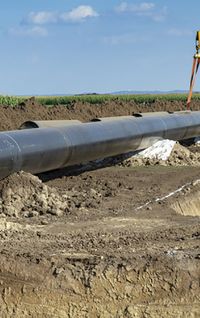Needing to continue to attract investment dollars from global infrastructure players, the US is confronting dual demands: remediation of decades of deferred investment and under-investment across multiple infrastructure asset classes, and investment in future-proofing US infrastructure assets, including combatting the effects of climate change. By Dolly Mirchandani, partner, White & Case LLP.
Back in 2018, the Congressional Budget Office estimated the US infrastructure funding gap to be a massive US$2.1trn. That figure is no doubt even higher today. Yet those who started investing in US infrastructure assets in the early 2000s and expected an avalanche of infrastructure investment opportunities are now in their second decade of waiting.
The Infrastructure Investment and Jobs Act (the Infrastructure Act) signed into law by President Biden on November 15 takes on the need to remediate under-investment and to future-proof. The Infrastructure Act promises to spend approximately US$1.2trn across a range of infrastructure asset classes from surface transportation and water to the electric power grid, broadband, and climate resiliency projects involving natural resource management.
Many in the infrastructure community in the United States and elsewhere who would love to put their private investment dollars to work alongside this public funding now find themselves wondering what role private investment will play in providing solutions, when those proposed solutions will be deployed and by whom.
Mind the gap
The US$1.2trn public funding commitment is a real shot in the arm for US infrastructure assets. While this amount falls short of meeting the full funding requirements, if leveraged appropriately with private sector investment dollars, the deployment of this public capital has a real chance of closing the US infrastructure funding gap and enabling the delivery of the state-of-the-art infrastructure assets and services that US taxpayers deserve. But the likelihood that these dollars will be leveraged effectively is far from certain.
The Infrastructure Act uses the familiar public funding toolkit of formula funding to allocate and deploy a significant portion of the dollars to states. States are likely to simply take the money and implement a first wave of so-called state of good repairs projects, tackling deferred maintenance and basic upgrades. Such projects can be expected to be procured under traditional design-bid-build or potentially design-build-procurement models without private investment or financing.
Notwithstanding the use of formula funding to generate improvements in the short term, the Infrastructure Act is not a short-term stimulus bill intended to create jobs and fix potholes. A full US$550bn is available as an infusion of new funding above baseline levels. More than half of that new funding has been allocated to the transportation sector, and many new grants and programmes have been specified as the vehicles through which the public capital will be deployed.
The terms of those grants and financing programmes remain to be developed and implemented by the federal governmental apparatus, principally the Department of Transportation, the Department of Energy and the Environmental Protection Agency.
Progress on partnerships
Those agencies are not the owners and operators of US infrastructure assets. It is the states and local governments, as the main infrastructure asset owners and operators, that will need to decide which projects to prioritise and which federal grants and financing options to compete for.
There is a prevailing theme in the Infrastructure Act related to private investment. Unlike other countries whose infrastructure policies were focused on incentivising private sector-led solutions to deliver their infrastructure assets, the US Federal government fundamentally does not see its role as requiring states and local governments to use private-sector investment in the form of long-term concessions or public-private partnerships (PPPs) to close the funding gap and deliver infrastructure assets. Rather, the federal government’s role continues to be one of an enabler or facilitator of private investment as one tool in a state or local government’s toolkit of available procurement options.
There is no express “tied” funding requiring use of private investment, and no express requirement to deploy “asset recycling” initiatives under which revenue streams generated by users of certain infrastructure assets such as toll roads and airports are utilised to build non-revenue generating infrastructure assets such as schools and civic buildings.
But US$100m has been allocated to a new programme within the US Department of Transportation to provide technical assistance and expert services to government entities contemplating and evaluating opportunities for PPPs. It has often been a significant challenge for states that lack PPP assessment and deployment expertise to access and afford the necessary technical, legal and financial skillsets to review and analyse all the necessary threshold project issues that drive a successful PPP procurement process and outcome. This programme has significant potential to direct the right expert resources toward delivery of complex infrastructure projects of national and regional significance that could readily benefit from the innovation and pricing competition that well-structured PPPs can deliver.
Applicants that want to access the low cost and increasingly flexible and favourable Federal TIFIA and RRIF loan programmes – now also available for airport and transit oriented development projects – for projects costing over US$750m will need to conduct a value-for-money analysis, including an assessment of life-cycle cost and project delivery schedule, to evaluate a PPP option. The analysis is intended to give the PPP model an opportunity to demonstrate its benefits, and finally puts whole-life costing on the table for upfront assessment for high-cost projects.
This approach could engender a shift in mindset from the prevailing focus on short-term project delivery, without adequate assessment and commitment of maintenance dollars, to a focus on long-term, optimised infrastructure asset delivery, together with the services associated with them. Such PPP structures would be underpinned by contractually mandated performance standards and real private dollars at risk of performance failures, mitigating the cost overrun and delay overrun risks that often plague US public procurements of large, complex projects.
The Infrastructure Act also increases the surface transportation private activity bond cap from US$15bn to US$30bn. Doing so empowers states to take advantage of lower financing costs while combining them with private-sector expertise, leveling part of the playing field with the availability of the subsidised low cost of tax-exempt financing to public agencies implementing their own projects.
Permitting backlog
Another piece of the puzzle that needs to come together before complex projects can be procured is completion of environmental reviews and permitting.
The Infrastructure Act codifies the “One Federal Decision Policy” implemented by the prior administration and requires crucial collaboration between the lead federal reviewing agency and related participating agencies, as well as guidance and a schedule for major projects. But up to a year may pass before the Department of Transportation publishes a rule for public review and comment. Even under this policy, permitting for complex projects can still be expected to take up to two years.
Next steps
Infrastructure investors in the United States will need continued patience. At least there is visibility on the federal funding commitments and financing tools available to states. However, the states are not yet ready to tender the volume of large-scale, complex projects that will provide investment opportunities commensurate with the huge volume of private capital available. Infrastructure needs will ultimately need to be developed into well-structured, investable and financeable transactions.
In the short term, states and local governments will need to turbo-charge their project planning, identification and readiness resources and capacity to enable access to the federal public capital on offer. Some view the current shortages in the supply of qualified engineers and construction workers, as well as construction materials and equipment, as a real impediment to deployment of this capital. But some short-term delays may prove to be a long-term blessing.
The inability to spend quickly could force states and local governments to slow down their capital deployment, and could open up the possibility of more thorough and thoughtful project readiness activities. These could, in turn, be more conducive to deployment of effective PPP procurement processes and innovative solutions.
Infrastructure projects in the United States have long been bedeviled by cost and time overruns, due to multiple issues that often include poor cost estimating caused by inadequate planning efforts and upfront diligence on major project risks, such as thorough geotechnical and archaeological studies, environmental assessments, utility identification and relocation management and land acquisition. If states and local governments have completed the necessary groundwork to enable firm cost estimates and scheduling assumptions on a sound and realistic basis, it will be far easier for states and local governments to seek and get the benefit of the fixed pricing and firm completion dates offered under a PPP solution.
This approach would serve to eliminate unnecessary contingencies due to “known unknowns” remaining at the time of procurement resulting in inevitable cost and delay overruns. This would also deliver long-term maintenance pricing with key performance metrics and related penalties for failures and reduce risk of history repeating itself with a legacy of deferred investment in the future.
Optimising risk allocation
Those states and local governments that focus on project readiness activities in high-risk areas for cost overruns and delays will be best positioned to reduce those risks and then efficiently transfer the remaining risks to the private sector, while retaining those that the private sector can neither influence nor manage effectively.
At the heart of this is states and local governments appreciating that PPP solutions are not vehicles for transferring all risks to the private sector. Many in the US have witnessed states and local governments thinking of PPPs as a means to transfer any and all risks to the private sector, including risks that have not been adequately assessed or quantified upfront.
State and local governments that take the necessary time and deploy the right expertise to complete project readiness activities will be best positioned to run efficient and effective PPP procurement processes. Such processes will generate real competitive tension and incentivise the private sector to innovate and deploy projects and solutions (especially those already developed and tested in countries with more advanced infrastructure assets) on time and on schedule, and to optimise long-term asset performance.
States in play
Which states are best positioned to capitalise on this once-in-a-generation opportunity to capture available federal funding and transform their infrastructure for the future?
White & Case recently conducted a survey among US infrastructure market participants that highlighted New York and California as key destinations for private sector investment, together with Florida and Massachusetts. When analysed from the perspective of states with strong existing public sector institutional capacity to assess and deploy PPPs effectively, the survey results reveal Texas and Virginia also leaping to the front of the line with projects that have long been in project planning and have been structured to maximise the benefits that the private sector can deliver.
Other states that learn from their example and effectively tap the new sources of federal assistance will be able to both close their infrastructure funding gaps and direct private investment into innovation-driven and optimised infrastructure that is fit for the 21st century.
Any views expressed in this publication are strictly those of the authors and should not be attributed in any way to White & Case LLP.
![]()
To see the digital version of this report, please click here
To purchase printed copies or a PDF of this report, please email gloria.balbastro@lseg.com

















